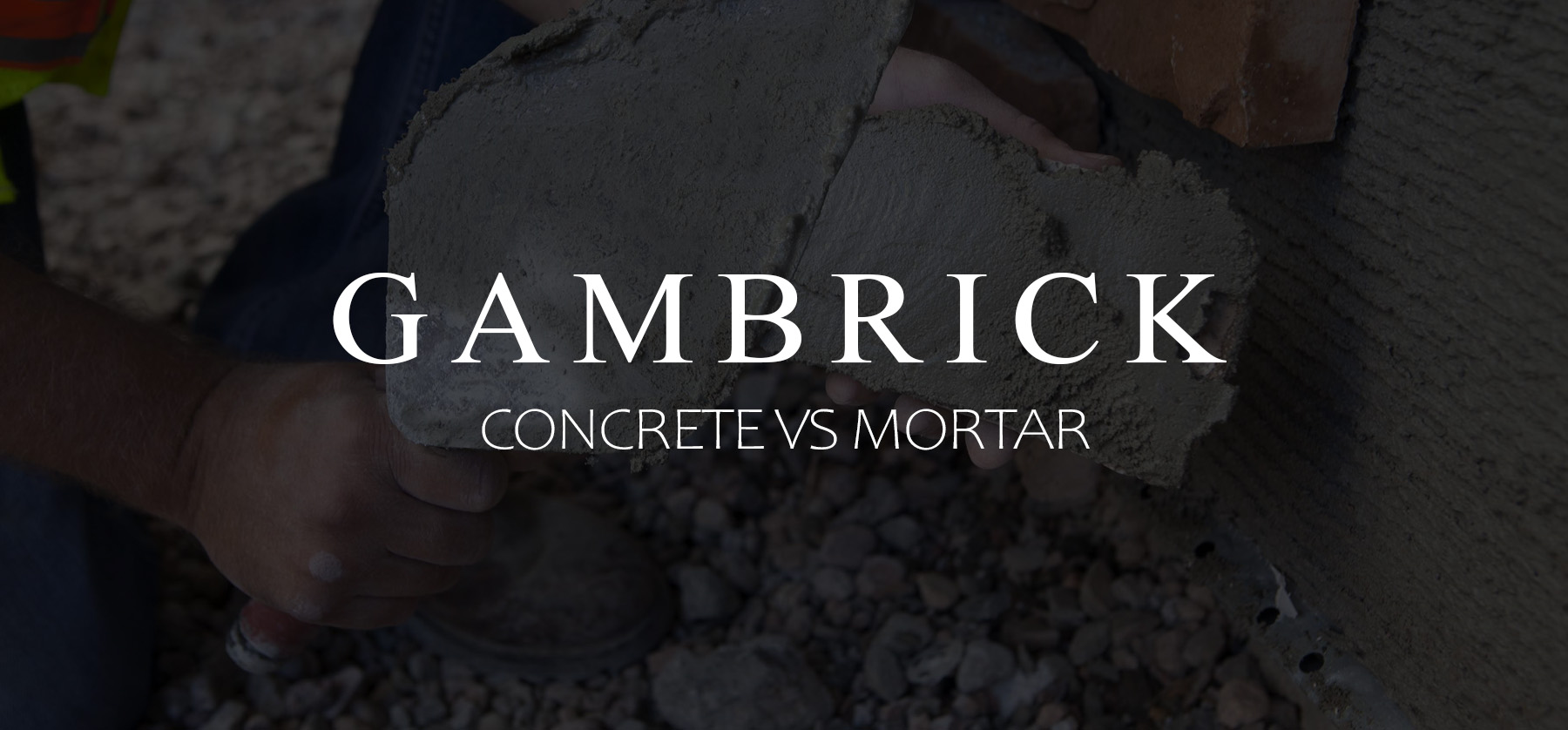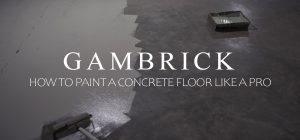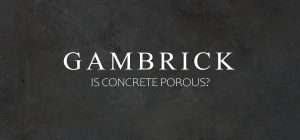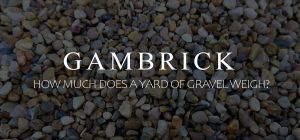
Concrete Vs Mortar
Concrete and mortar are made in almost exactly the same way with the same basic ingredients. They’re both primarily sand and cement mixed with water. The major difference is that concrete also mixes in aggregate stone which greatly increases it’s strength and durability. The drawback to that added strength is that concrete is heavier and harder to work with. I’ve been working as a mason for over 25 years and can tell you that comparing concrete vs. mortar won’t have a clear winner. They’re both very important materials that serve a different purpose when building a home.
If your building a foundation, then you’ll definitely want the increased strength of concrete. An all mortar foundation would easily crack under heavy loads without stone aggregate. But if you’re laying brick or stone, mortar is better at binding them together to create strong joints.
Cement is weaker than concrete and mortar, but it’s used to make both. In fact, there’s no way to make concrete or mortar without sand, water, and cement.
A benefit of mortar is that it’s easier to smooth in thin layers like a parge coat. The stones in concrete make it difficult to use when poured very thin and prone to cracks.
When used as a grout, mortar is much better than concrete. The stones used in concrete make it too thick to use as grout unless the gaps between materials are huge.
Concrete is typically mixed with a lower water-to-cement ratio, and has aggregate stone which makes it stronger. Mortar is weaker, has a higher water-to-cement ratio, finer aggregate, and is used as a binding material for bricks, blocks, or tiles.
If you need structural support or an anchor, use concrete, but if you’re bing two materials like brick or stone together, use mortar.
Concrete & Mortar Use Cement
The terms concrete, mortar and cement are often used interchangeably by people outside the construction industry because all three of them are used in masonry as either a binding or building material. But even though these materials are related, they’re purpose is very different. It’s important to understand what each of them does and how they’re used.
Cement
Cement is a binding material that’s used to make mortar and concrete. Mortar is made out of cement and sand mixed with water. Add in aggregate stone and you get concrete. The most popular type of cement is Portland Cement. You can buy it by the bag at just about any Home Improvement store.
Portland Cement is made mostly of limestone and chemicals like calcium, silicon, aluminum, and iron. It also contains shells and chalk combined with shale, clay, slate, slag, sand, and iron ore. It’s a hydraulic substance, which means the chemicals in its mixture will harden once water is added.
Cement is almost never used by itself. Rather, it’s the main binding agent for making both concrete and mortar. It can also be added to materials like stucco, grout, and other adhesives and coatings.
Without cement, you couldn’t build almost anything out of masonry because the materials wouldn’t bind together or get hard. So in this regard, the most important part of a masonry project is typically the cement.
Mortar
Mortar is a mixture of cement and sand aggregate. The best type of sand to use for mortar is typical beach or river sand and not powder. Adding sand to cement makes it stronger, easier to form, more durable and crack resistant.
Mortar is basically a weak form of concrete. It has excellent adhesion which is why mortar is great for sticking stone to a wall or stacking bricks. It’s a great binding agent. Most masonry walls and stone work are built with mortar. But it doesn’t have the same compression strength as concrete, which is why it’s not used to build foundations or large structures.
Mortar uses slightly more water than concrete. You should be able to hold concrete in your hand and form it into a ball when it’s properly mixed. Mortar, on the other hand, is too wet to hold a form.
Most mortar mixes have a compressive strength of around 1500 psi. Although some go as high as 3500 psi. These levels are not strong enough enough to support large structures like a foundation or poured walls. Mortar also cracks much easier than concrete which is why it’s not used to build sidewalks or patios. Mortar isn’t even strong enough to build a simple set of masonry steps. However, when you build a steps or a foundation with concrete, it’s mortar that later secures the brick or stone work.
The following materials are what mortar is best used for:
- Bricks. Used to stack brick and fill joints.
- Tiles. We use mortar to stick the tiles but grout to fill the joints.
- Blocks. Binds blocks together and fills joints.
- Stone. Mortar is used to stack large stones together to build walls or secure thin stone and stone veneer to a wall. It’s also used to fill joints.
Concrete
Concrete is one of the most popular building materials in the world. It’s strong, durable, resistant to the elements and easy to work with. You just build forms and pour the concrete.
It’s made from cement and sand just like mortar, but it also includes aggregate stone that ranges in size between 1/2 inch to an inch. Because of it’s high strength, concrete is used to build a wide variety of structures ranging from sidewalks, patios, and steps to foundations, buildings, and even dams.
Concrete continues to harden over time which is called curing. This generally takes around 28 days to complete. As concrete cures, it increases in strength and durability. It’s main attribute is compressive strength which is measured in psi or pounds per square inch. You can even buy concrete in premixed Quikrete bags as strong as 5000 psi. It’s because of this high compressive strength that concrete is used to build the vast majority of foundations.
Below is a list of the different kinds of applications concrete is used for:
- Buildings & Homes. Footings, foundations, floors, roofs and walls are built with formed and poured concrete or blocks.
- Bridges. Footings and foundations are built using concrete.
- Roads. Concrete is very strong and crack resistant which is why it’s such a fantastic road material.
- Dams. Most dams are built using extremely thick reinforced concrete.
- Patios & Sidewalks. Concrete is crack resistant and very strong which makes it great for flat work.
Concrete can also be reinforced using things like fiber, wire mesh and rebar. This adds even more strength, durability, crack resistance and versatility.
One of the best things about concrete is how easy it is to form. Pour it into any form and it will permanently harden into it’s containers shape.
Strength And Durability
The reason why there’s a difference between concrete vs mortar is the stone. Adding stone aggregate to mortar makes it a lot stronger, more durable and crack resistant, but it also gets less sticky and harder to work with.
Concrete is much stronger in terms of compressive strength. It’s used when you have to support a lot of weight. Such as the footings that supports a large building or home. It’s also crack resistant which makes it a great material for large slabs and roads. But it’s not as sticky and the stones make it hard to fill gaps with. The average concrete mix uses stones between 1/2 inch to an inch which means your joints would have to be at least 1 1/2 – 2 inches. That’s way too thick for bricks and most stone work. Concrete is also harder to finish smooth when applied vertically because of the stones.
On the other hand, mortar is stronger than concrete is terms of tensile strength. This is the measure of how hard something is to pull apart. Even a thin coat can bond stone or brick together when stacked or attached to a wall. Although it can’t support as much weight which is why mortar can’t be used to build tall walls without reinforcement.
Concrete also gets much harder than mortar which means it can actually be too hard to use with brick and soft stone. If there’s any movement, the concrete joints won’t give so the brick or stone will crack. What you want is the brick and stone to stay solid and the joint to fail. Another benefit of using mortar.
Both concrete and mortar have good strength and durability. Which is best really depends on the application.
Concrete Vs Mortar: Which Is Best
If your comparing concrete vs mortar to determine which is best, it all depends on the application. There’s no clear cut winner because they’re designed to do different things. Let’s look at a few examples.
- Let’s say your building a home and have to choose a footing materials. Then in this case concrete is the clear winner. The compressive strength is much higher which means it can support the weight. Mortar has much less compressive strength which means it will crack under a heavy load.
- Now let’s say your building a brick wall. Then in this case mortar is the best choice. Concrete is much too stiff and stone means you’ll need very thick joints. It’ll also be near impossible to get a smooth joint.
- What about installing thin brick or stone veneer. Then again, mortar is the best choice for both the installation and joint fill. Concrete is too stiff, thick and hard to finish.
- What abut something like a fence post footing. Fence posts are set in the material and not on top so compression isn’t an issue. But in this case the superior strength and weight of concrete makes it a better choice. But mortar would still work if that’s all you’ve got.
- It’s much better to build a slab out of concrete. It’s stronger, holds more weight and is crack resistant.
- Thin coats should always be done with a mortar because it doesn’t contain stone aggregate.
If you look at all these examples you’ll find one thing in common. Concrete is better if you need strength, crack resistance for slabs or you have to support a heavy load. Mortar is better if your sticking one thing to another, forming joints or doing smooth finish work with thin coats.
Types Of Mortar
Mortar comes in five basic types that are designed for different applications. If your comparing concrete vs mortar to figure out which is best, you need to understand the different types of mortar there is to chose from.
The ingredients are the same with each type but the ratios are adjusted. Below is a table of the different mortar types listed from strongest to weakest along with the ratio of Portland Cement, Sand, and Lime needed to make them.
| Mortar Type | Portland Cement | Sand | Lime |
| M | 1 | 3-1/2 | 1/4 |
| S | 1 | 4-1/2 | 1/2 |
| N | 1 | 6 | 1 |
| O | 1 | 9 | 2 |
| K | 1 | 12 | 3 |
Type M Mortar
Type M mortar is the strongest with a psi rating of around 2,500. While this is the strongest type of mortar, it’s not as strong as concrete. It’s primarily used when dealing with hard stone. Because of its strength, Type M is not as easy to work with as other types of mortar.
Type M is considered a specialty mortar and not for general all around use. Some of its common uses include:
- Loads too heavy for other mortar types that can’t use concrete such as thin joints supporting stacked stone.
- Below ground work.
- Some foundation and driveway applications.
Type S Mortar
Type S mortar is the second strongest mortar in terms of compressive strength. It has an average psi of around 1,800 along with a higher tensile strength than other mortar types. It can withstand both wind and seismic pressures and does well underground.
Some common uses include:
- Below grade work.
- Manholes & Sewer work
- Some foundation applications.
- Securing large or heavy stones to a wall.
Type N Mortar
Type N is the most popular mortar type. It’s considered a good all around general use mortar for all sorts of residential and commercial projects that are above ground.
Type N only has a medium compressive strength of around 750 psi which means it cracks easily. Although it’s tensile strength is strong. For this reason Type N is very good for installing thin brick, tile and stone veneer, brick work, filling joints and stacking brick and light stone.
Some common uses include:
- Stacking light to medium loads.
- Above grade uses like brick and stone work.
- Installing thin brick, tile or stone veneer to a wall.
- Soft stone masonry.
Type O Mortar
Type O mortar has around a 350 psi rating which makes it fairly weak. For this reason it’s mainly used for interior repair projects. Even though it’s used indoors we don;t use it for any new work. If your doing indoor stone or brick work then use type N or stronger. But if you have some small cracks to repair type O is fine.
The reason we occasionally use type O instead of other types of mortar for repair work is because of how easy it is to mix and work with.
This type or mortar is not recommended for use on anything structural. It does not hold up well against high winds or seismic activity which is why it shouldn’t be used outdoors.
One common use:
- Repairing existing mortar joints. It’s important that you don’t use mortar that’s harder than the existing mortar when repairing since the new harder mortar can cause cracking.
Type K Mortar
Type K is the weakest of all the mortar types with an average psi of just 75. Most people will ever have to deal with type K since it has very little real world applications. It’s used to preserve historical sites or anything fragile that can be damaged easily by stronger mortar.
Concrete Types
Although concrete doesn’t come in types, by varying the ingredient ratios and adding additional elements, you can adjust the strength of concrete and give it some special features. These include:
- Fast Setting. Quikrete makes a concrete that sets and hardens in as little as 15 minutes. This really comes in handy when doing work like pouring fence posts or repairing steps.
- Crack Resistant. This is another great feature for things like patio or sidewalk repairs.
- Permeable. Concrete that drains is a new design. Large and jagged aggregate stone is mixed into concrete which creates small tubes where water can run through. This is a great feature in large slabs like highways where drainage is an issue. Typically this type of concrete isn’t used in residential work.
- Strength. The most common variable with concrete is it’s strength. When you look at a bag of Quikrete that says 3500, that number means 3500 psi. BY varying the ratio of cement, sand and stone you can adjust it’s strength. More stone means stronger concrete. Although the downside to adding stone is that the concrete becomes harder to work with.
Some weaker concrete batches can be used in place of mortar if the stones are small. Stick with 1/4 inch aggregate. That’s stick a big stone compared to most mortars but it’s thin enough to allow a 1/2 inch joint. With batches like this you could even use concrete as a veneer. However you also need to adjust the ratios a bit and add more cement to stone than usual.
Concrete is a very versatile material that can be adjusted to meet almost any project’s requirements.
Summary: Concrete Vs Mortar
Concrete and mortar are made in almost exactly the same way with the same basic ingredients. They’re both just sand and cement mixed with water. The major difference is that concrete also mixes in aggregate stone which greatly increases it’s strength and durability. The drawback to that added strength is that concrete is heavier and harder to work with. So when you compare concrete vs mortar it all depends on what the project specs call for. If your building a foundation, then you’ll definitely want the increased strength of concrete. An all mortar foundation would easily crack under heavy loads with the aggregate. But if your laying brick or stone, mortar is what you want to hold them together and create strong joints.
Another benefit of mortar is that it’s easier to smooth. This makes it great for parge coats on a foundation. The stones in concrete make it difficult to use vertically or when the coating is too thin. Generally concrete cracks when it’s poured under 4 inches thick.
Concrete is typically mixed with a lower water-to-cement ratio, and has aggregate stone which makes it stronger. Mortar is weaker, has a higher water-to-cement ratio, finer aggregate, and is used as a binding material for bricks, blocks, or tiles.
There are different types of mortar just like there are different types of concrete. Ingredients ratios can be adjusted depending on what you need the concrete or mortar to do.
If you have any questions or comments e-mail us any time. We’d love to hear from you.

John Mazzuca | About | More Posts |
Custom Home Builder
John Mazzuca is a custom home designer and builder at Gambrick with over 25 years experience in the construction industry. John has designed, built and/or remodeled hundreds of homes, small buildings, and commercial projects. He writes about business, real estate, home building, and household electronics. His work has been featured in Fox Business, Better Homes & Garden, House Beautiful, and more.




















